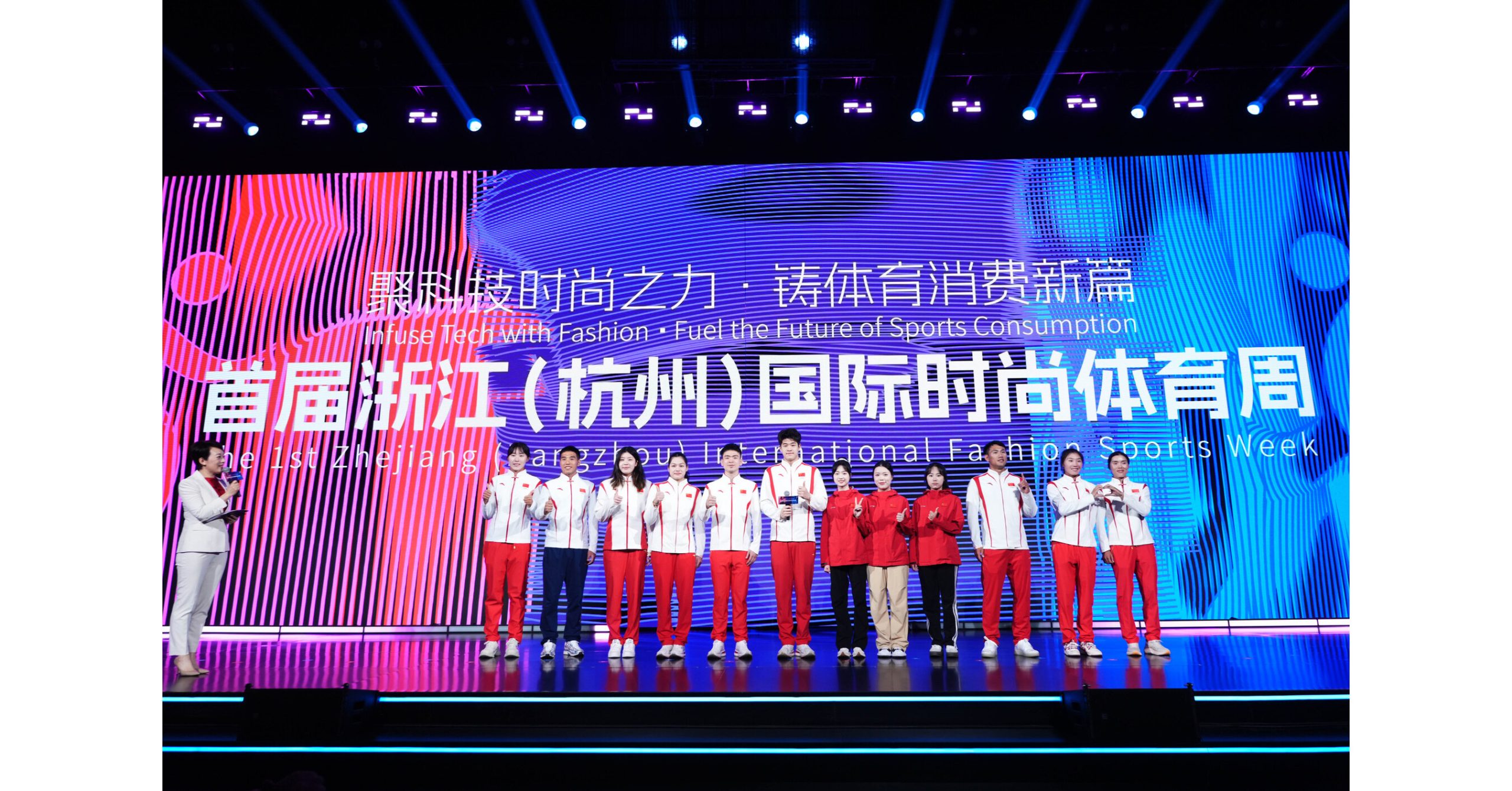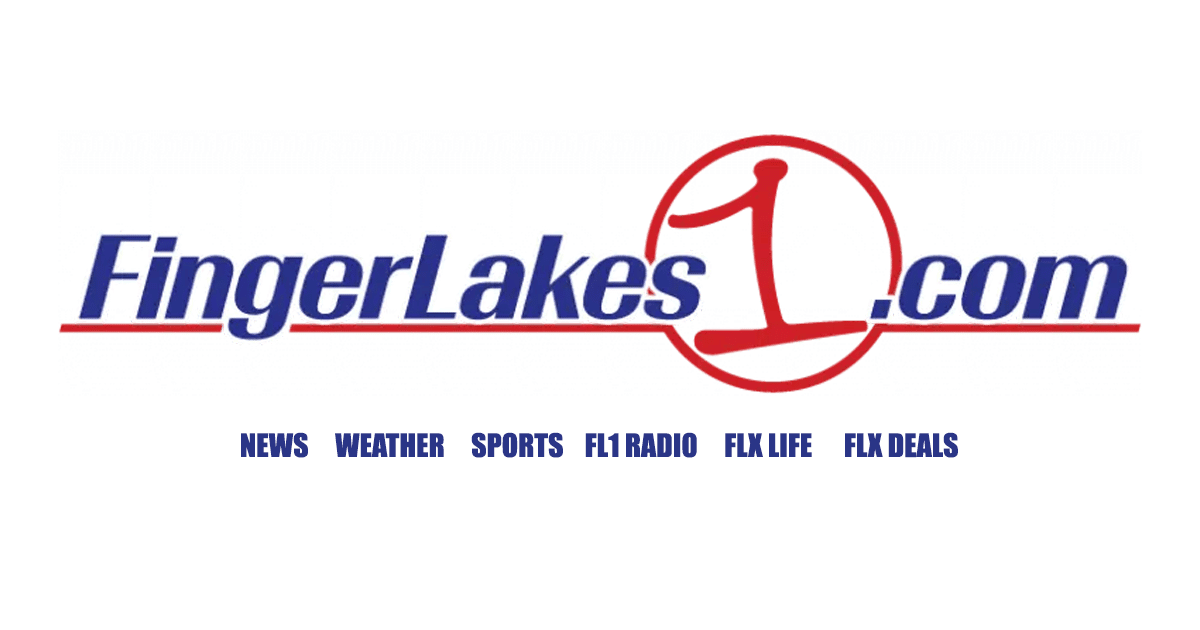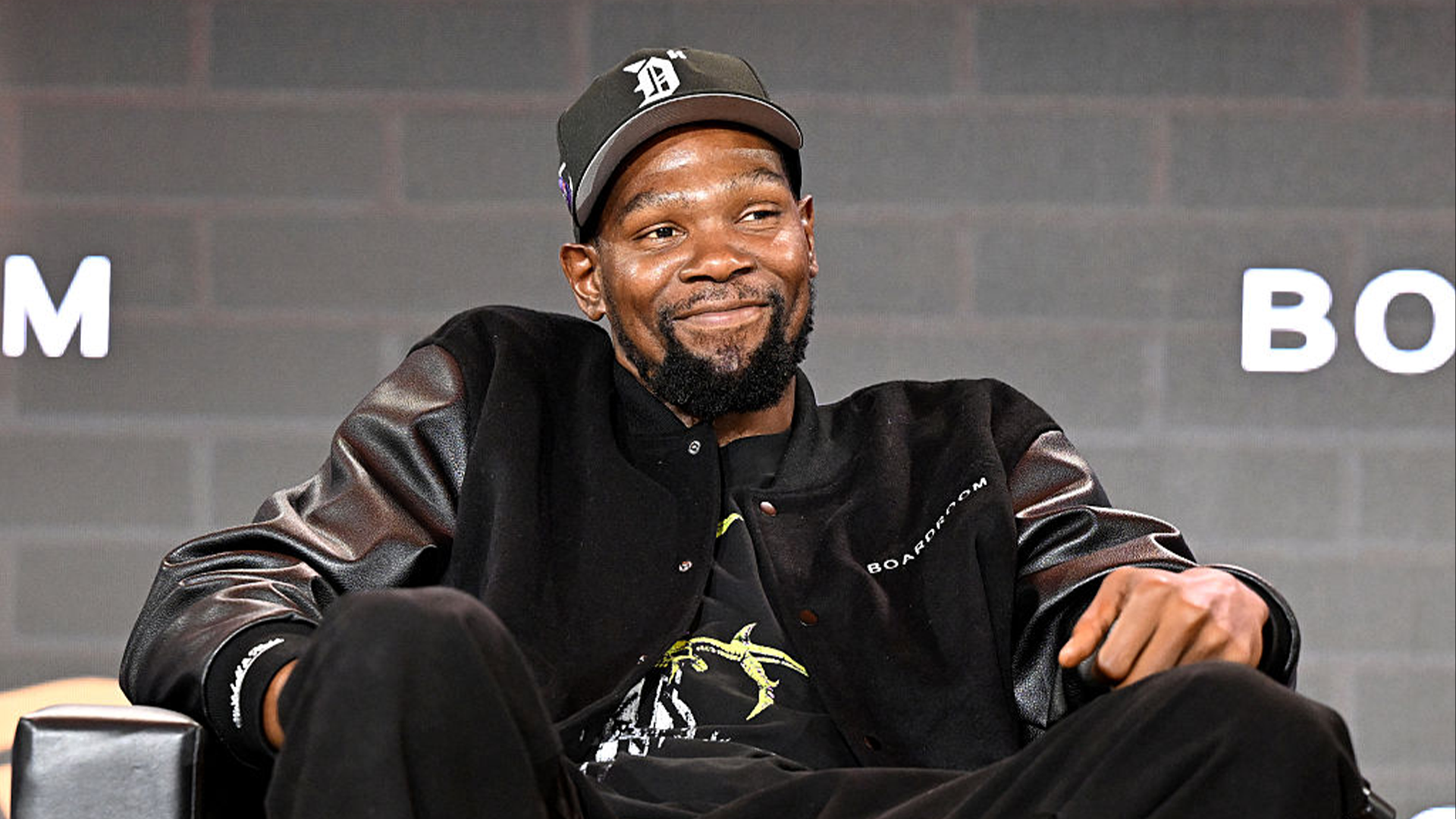Technology
1st Zhejiang (Hangzhou) International Fashion Sports Week Debuts with Olympic Champions Inspiring Community Participation
HANGZHOU, China, May 1, 2025 /PRNewswire/ — The inaugural Zhejiang (Hangzhou) International Fashion Sports Week was launched on April 30 and will run through May 5 across two premier venues: E-Fashion Town in Linping District and Zhejiang Huanglong Sports Centre. Themed “Infusing Tech with Fashion and Fueling the Future of Sports Consumption”, the event is hosted […]

HANGZHOU, China, May 1, 2025 /PRNewswire/ — The inaugural Zhejiang (Hangzhou) International Fashion Sports Week was launched on April 30 and will run through May 5 across two premier venues: E-Fashion Town in Linping District and Zhejiang Huanglong Sports Centre. Themed “Infusing Tech with Fashion and Fueling the Future of Sports Consumption”, the event is hosted by the Sport Bureau of Zhejiang Province with support from Hangzhou Sport Bureau, Linping District People’s Government, Xihu District People’s Government, and Zhejiang Huanglong Sports Centre. The convergence of sports, fashion and cutting-edge technology creates a dynamic platform to reimagine athletic lifestyles and accelerate industry innovation.
1st Zhejiang (Hangzhou) International Fashion Sports Week Debuts with Olympic Champions Inspiring Community Participation
The six-day program is structured around a “1+3+N+1” format, designed to integrate large-scale production with community engagement:
- 1 Official Opening Ceremony
- 3 Core Events: A sportswear design competition, an athletic fashion trend showcase, and an innovation expo spotlighting performance gear
- N Public-facing activities: A Fashion Sports Shopping Festival, a Sports Gear Pop-Up Market, a RV Camping Rally, a “Village Tents” Rice Field Carnival, a Citywide Fitness Challenge, and an E-Fashion Music Festival
- 1 Closing Highlight: an exclusive release of the year’s Sports Trend Rankings
Olympians Take Spotlight in the Kick-off Event
A roster of Olympic and world champions from Zhejiang took the spotlight during the April 30 launch at E-Fashion Town, with them stepping into their roles as official ambassadors of Fashion Sports Week. Among them are freestyle swimmer Pan Zhanle, shooting prodigy Huang Yuting, badminton star Zheng Siwei, decorated athletes Yang Qian, Wang Zhilin, and Dong Xiya. Their presence adds star power to the weeklong event, helping to bridge professional athleticism with daily lifestyle and drive broader public engagement.
Throughout the week, the athletes will appear in key experiential zones:
- Fashion Tech Runway: Showcasing experimental activewear that blends AI-generated design, biodegradable fabrics, and local craft traditions
- Emerging Sports Hub: Offering interactive demos in flag football, land-based Stand Up Paddle (SUP) yoga and other trending disciplines
- Smart Tech Pavilion: Allowing attendees to test AI fitness avatars and cutting-edge wearable audio tech
- “Village Tents” Carnival: Featuring informal athlete storytelling sessions amid family-friendly camping activities
These activities are providing participants with the opportunity to connect closely with sports stars in an engaging way, while showcasing the sports lifestyle as a platform for design, innovation, and cultural exchange.
Champion-Led Appeal Drives Retail and Community Momentum
Zhejiang (Hangzhou) International Fashion Sports Week is also a lever for local economic stimulation, with initiatives that blur the line between consumer experience and retail activation:
- Government-backed voucher programs totaling millions of yuan for use on sports gear, cultural collectibles, and wellness snacks
- Limited-edition collections co-branded with Olympic ambassadors
- Free public access to activities like roller skating, water sports, and archery—plus prize giveaways including signed gear
- Lifestyle programming designed for families and pet lovers, including a pet-athlete runway and community camping experiences
With expectations of drawing more than 100,000 visitors, the event aims to generate wide-ranging impact across local retail, hospitality, and tourism sectors. “Olympic ambassadors consider this much more than a celebration—it becomes a vehicle for economic and industrial transformation,” said a representative from the Zhejiang Provincial Sports Bureau,”By integrating fashion-tech into the athletic sphere, we’re shaping a high-value model for China’s next phase of consumption-driven growth.”
SOURCE Zhejiang (Hangzhou) International Fashion Sports Week Organizing Committee

Technology
Incline walking or running, which is better for burning fat? Surprising study
Walking is easier than running, but it still comes along with plenty of benefits. Studies show just two minutes of walking around the block helps blood sugar levels rise and fall more gradually and stabilize insulin levels. A brief 10-minute walk could lower blood pressure, and my mood always perks up when I walk my […]

Walking is easier than running, but it still comes along with plenty of benefits. Studies show just two minutes of walking around the block helps blood sugar levels rise and fall more gradually and stabilize insulin levels. A brief 10-minute walk could lower blood pressure, and my mood always perks up when I walk my two little fluffy dogs around the block and see their wagging tails and smiling faces.
When it comes to achieving weight loss, researchers found that walking can help promote weight loss, so it’s worth setting off on foot, even if you’re short on time. Recently, researchers wanted to explore whether incline walking or running is better for burning fat. Incline walking is harder than it looks, and you’ll definitely feel your muscles working, especially those larger leg muscles.

When I was undergoing physical therapy for three months, my physical therapist often had me walk on an incline treadmill at the start of my workout. There are plenty of proven benefits of incline walking, including increasing heart rate and strengthening knee joints. Incline walking challenges your musculoskeletal system. What about when it comes to burning fat? Let’s explore the latest research.
The study

In a study published in the International Journal of Exercise Science, researchers aimed to compare the metabolic responses of the 12-3-30 treadmill workout with self-paced treadmill running. The 12-3-30 workout involves walking on the treadmill with a 12% incline at 3mph for 30 minutes. Participants weren’t allowed to hold on to the handrails. Participants also had to go on runs and stop running when they burned the same amount of calories as their 12-3-30 workouts. In one week, participants had to perform one self-paced run and one 12-3-30 workout. A self-paced run is where you choose your own intensity and speed that feels more comfortable for you.
The researchers measured whether participants obtained more energy from carbohydrates or fat during exercise.
The results

Interestingly, the results showed the following:
- Running burned 33% of calories from fat, whereas incline walking burned 40% of calories from fat.
- Despite burning the same calories, it seems incline walking is 7% more effective for fat burning than running.
- Running resulted in a faster calorie burn, seven minutes faster than incline walking, to be precise. However, running relied more on using carbohydrates for fuel rather than fat.
- Fat was the preferred fuel source for lower-intensity incline walking.
Incline walking is a type of zone 2 training that effectively raises your heart rate to around 65-75% of your maximum heart rate.
Concluding thoughts

It’s important to note that this is a small study, but it’s interesting to consider how low-intensity cardio can be more effective for burning fat and using fat as a fuel source. That being said, if you’re limited on time or you just really don’t want to spend 30 minutes on the treadmill, running outdoors might be the best choice. You’re more likely to stick to what you enjoy.
Technology
Smarter Deliveries & Even More Automation
As the logistics world is changing fast, tech is at the center of it all in 2025. From warehouse robots to delivery drones, companies are stepping up their game to move things faster, safer, and with less waste. More than 80% of logistics businesses are planning to digitize operations. That means fewer paper logs, more […]

As the logistics world is changing fast, tech is at the center of it all in 2025. From warehouse robots to delivery drones, companies are stepping up their game to move things faster, safer, and with less waste.
More than 80% of logistics businesses are planning to digitize operations. That means fewer paper logs, more real-time tracking, smarter inventory systems, and better planning tools. Logistics software vendors, in turn, adopt the latest AI, IoT, and blockchain practices to make it happen.
Now, let’s take a closer look at the latest technology trends from Acropolium’s custom logistics solutions — one of the leading tech partners for supply chain businesses.
1. Smarter Warehouses with Automation & Robots
In 2025, robots are picking, sorting, and moving items around automatically. These bots help speed up the process and reduce mistakes, while workers focus on more strategic tasks.
Think conveyor belts with eyes and hands, or robotic carts that follow paths across the warehouse floor. This automation helps companies deal with labor shortages and ramp up productivity, especially during busy seasons.
Moreover, many of these systems come with built-in AI tools that help predict demand so companies know what to stock up on and when.
2. AI Is Taking the Wheel
AI and ML are the logistics technology trends that dig through piles of data to uncover patterns and help companies make smarter decisions: which route will be fastest, where delays are likely, or when a truck might need maintenance.
Companies using AI have cut logistics costs by 15%, reduced overstock by 35%, and improved delivery times and service by over 60%.
3. Blockchain, Not Just for Crypto
In logistics, blockchain creates a digital paper trail that can’t be tampered with. Every product gets a digital ID, showing where it came from, who handled it, and what condition it’s in.
That’s useful for tracking things like food safety, verifying sustainability claims, or cutting down on fake goods.
4. Real-Time Tracking with IoT
The Internet of Things (IoT) connects containers, trucks, and pallets to the internet. Attach a sensor, and you can track location, temperature, humidity, or even vibrations in real-time.
It works great news for sensitive shipments like medicine or fresh food. For example, if a truck’s temperature rises too much, alerts go out instantly. You always know where your stuff is, and what shape it’s in. IoT is also used to spot vehicle issues early, so breakdowns don’t ruin delivery schedules.
5. Virtual and Augmented Reality Training
VR and AR are helping train warehouse staff faster and more safely. With a headset, a new worker can learn how to handle equipment or pack orders correctly without ever setting foot on the warehouse floor.
AR glasses can guide employees with on-screen instructions as they walk around. And for customers, AR can add transparency. Some companies are letting users see live tracking data through mobile apps with interactive maps or 3D views.
6. Big Data: Making Better Decisions
Every delivery, order, and inventory move creates data. In the past, this info was underused. Now, with big data tools, logistics teams can spot trends, forecast demand, and avoid slowdowns before they happen.
For example, shipping companies can use weather data to avoid storm delays, or analyze past orders to prep stock in the right regions before demand spikes.
As a result, you can have fewer delays, better stock control, and smarter planning.
7. Greener Logistics & Sustainability
From electric delivery vans to route optimization that cuts down fuel use, companies are working hard to reduce their carbon footprints.
Warehouses are also getting makeovers with energy-efficient lighting, solar panels, and smart HVAC systems.
Then there’s reverse logistics: recycling, refurbishing, or reusing returned products. It’s all about extending product life and cutting waste. More than two-thirds of consumers now say they prefer eco-friendly brands, so this trend isn’t going anywhere.
8. Drones and Driverless Deliveries
While self-driving trucks and delivery drones won’t replace drivers overnight, they’re already making an impact on short routes and in rural areas.
Drones, for example, are dropping off medicine and small packages where regular deliveries take too long or cost too much. As traffic systems get smarter and laws catch up, we’ll likely see these tools playing a bigger role in how goods move.
9. Digital Twins as the Supply Chain’s Crystal Ball
A digital twin is basically a virtual model of a physical object or process. In the logistics context, this could mean creating a digital copy of a warehouse or transport route to test “what-if” scenarios before making changes in real life.
Say you’re planning a new delivery route or changing warehouse layout — running simulations on a digital twin can show how it’ll affect time, cost, and efficiency before you spend a dime.
Conclusion
In 2025, logistics is all about working smarter, not harder. With AI, automation, sensors, and virtual models, companies are cutting costs, boosting speed, and reducing waste. And all of that results in more accurate deliveries, greener operations, and a better experience for everyone involved.
Whether it’s a warehouse robot or a flying drone, the future of logistics is here — with the power of technology, it changes the supply chain for the better.
Technology
Kevin Durant Signs Deal With Qatar Sports Investments To Become An Investor In Paris Saint-Germain
New changes are underway for professional basketball star Kevin Durant on and off the court. Durant is experiencing shifts within his expanding business portfolio. Durant is now an investor in the Champions League winner Paris Saint-Germain (PSG), having purchased a minority stake through Boardroom Sports Holdings, his investment arm established alongside his business partner, Rich […]

New changes are underway for professional basketball star Kevin Durant on and off the court.
Durant is experiencing shifts within his expanding business portfolio.
Durant is now an investor in the Champions League winner Paris Saint-Germain (PSG), having purchased a minority stake through Boardroom Sports Holdings, his investment arm established alongside his business partner, Rich Kleiman, according to Sports Illustrated.
He signed the deal with Qatar Sports Investments (QSI), PSG’s majority shareholder.
“QSI is pleased to welcome Kevin Durant as a direct shareholder in Paris Saint-Germain and strategic partner of our group,” QSI Chairman Nasser Al-Khelaifi said in a company press release. “We continually seek to elevate the club and our broader portfolio through high-impact partnerships that bring strategic value, innovation, and global perspective. Together with Kevin, we look forward to developing ambitious initiatives that will drive the continued global growth of Paris Saint-Germain and QSI.”
In the press release, Durant expressed excitement about the new deal, stating that Paris and the club hold a special place in his heart.
“This club has big plans and I look forward to being part of the next phase of growth and exploring new investment opportunities with QSI,” he said.
Durant will advise “on Paris Saint-Germain’s multi-sport strategy, including potential plans in basketball.”
New opportunities are expected to come from this partnership across various commercial ventures, investments, and content initiatives. Durant will also assist with Paris Saint-Germain’s growth in the U.S. and internationally, as mentioned on Boardroom’s website.
On the court, the Phoenix Suns reportedly traded the 15-time All-Star to the Houston Rockets on Sunday, according to the NBA.
The news broke while Durant was on stage at Fanatics Fest NYC, described as the world’s largest arena for sports and collectibles for enthusiasts, athletes, and collectors on its website.
“Anything can happen at Fanatics Fest, like me getting traded, but being a part of the Houston Rockets, I’m looking forward to it,” Durant said in an interview with Sports Commentator Kay Adams.
Technology
AI, new clot-busters enable faster blood clot care | Moves in Medicine
PHILADELPHIA (WPVI) — From smoking to living in the South, many people face a higher risk of a pulmonary embolism: a blood clot in the lungs. Now with technology, new drugs, and specialized care, a local team is working for better outcomes. Last year, Stephany Brown fulfilled a lifelong dream – taking a cruise. “It […]

PHILADELPHIA (WPVI) — From smoking to living in the South, many people face a higher risk of a pulmonary embolism: a blood clot in the lungs.
Now with technology, new drugs, and specialized care, a local team is working for better outcomes.
Last year, Stephany Brown fulfilled a lifelong dream – taking a cruise.
“It was part of our 20th wedding anniversary,” Stephany remembers with a smile.
But she also remembers last year for surviving a pulmonary embolism.
After being startled at work, her fitness tracker said her heart was in overdrive, and couldn’t slow down.
She was also getting short of breath.
“My mother was adamant – ‘You need to hurry up and go to the hospital,’ ” she recalls.
At Temple University Hospital, tests quickly found the cause.
“There were blood clots in both lungs, and they were extremely big,” she notes.
“A blood clot that starts in the leg, breaks off, comes to the lung – It can affect anyone. It spares no one,” explains Dr. Parth Rali, a Temple Health thoracic surgeon.
Dr. Rali says P-E’s can come without warning, block blood flow and cause heart or lung damage.
A third of people with them die before getting a diagnosis and treatment.
To find lung clots faster, Dr. Rali’s team uses A-I software to read CT scans.
“If it detects the blood clot, it will put it at the top of the queue for the radiologist,” he explains.
“Instead of waiting for 5, 6 hours, you are getting reads in like 2 minutes, 3 minutes, 4 minutes,” he says.
The P-E response team gets an alert, so they can start blood thinners faster and plan other treatments – such as a catheter that puts drugs right into the clot.
“I get it right on my phone. I don’t need to look for a computer,” he adds.
Dr. Rali is also testing A-I guided ultrasound even non-technicians can use.
“It will self-prompt you, saying go here, go here, go – next steps,” he says, adding, “How fast you act changes your trajectory, meaning that how well you’re going to do.”
Stephany took part in trials of a new clot-busting drug.
Because the clots shrank so fast, she thinks she got the drug, not a placebo.
Now, her family is back making plans.
“We’re gonna cruise in December again. I think we’re addicted to it now,” she says with a laugh.
She’s also back on her weight loss journey, losing 95 pounds so far.
Dr. Rali says long-term follow-ups with both specialists and primary care is essential to preventing future clots.
Copyright © 2025 WPVI-TV. All Rights Reserved.
Technology
Calling all gadget geeks! The fanciest new fitness tech to turbo-charge your workouts
From the £69 sore muscle miracle-worker to the £600 futuristic recovery boots that’ll be on every athlete’s Christmas list this year, we’ve got the best fitness tech to boost your strength, speed and endurance. And make you look cool at the gym… Any products in this article have been selected editorially however if you buy […]

From the £69 sore muscle miracle-worker to the £600 futuristic recovery boots that’ll be on every athlete’s Christmas list this year, we’ve got the best fitness tech to boost your strength, speed and endurance. And make you look cool at the gym…
Any products in this article have been selected editorially however if you buy something we mention, we may earn commission.
Here at Get the Gloss, we love a clever gadget to boost our fitness, whether a high-end luxury treat (a Prada padel racket? Why not!) or practical and affordable (we were early adopters of weighted vests).
An increased awareness of the importance of fitness means that more of us are taking steps (literally) to be less sedentary. The global under-desk treadmill market alone reached $131.8 million in 2024, and is predicted to skyrocket to $203.8 million by 2033, according to market research firm Imarc Group. Plus more of us than ever are investing in what might previously have been considered niche products and the preserve of elite athletes, such as compression therapy devices.
While some might argue that investing in fitness kit is simply a way to delay doing the actual hard work of getting fitter, writer Oliver Burkeman says it can be a powerful tool. “Taking pleasure in the equipment that you use can be a positive force,” says the author of Four Thousand Weeks: Time Management for Mortals, £9.03. “I’m not in favour of the approach that says: ‘You don’t need nice running gear to run.’ Yes, focusing on that can go too far, leading to avoidance and procrastination, but getting pleasure from the tools you use makes you more likely to do the thing.”
So are the 10 fitness tech gadgets that we really rate right now – and, here’s hoping, will make you more likely to do the thing.
Technology
FunFitLand Is A Compelling Workout On Quest With Mixed Reality & Hand Tracking
Over the past 14 months I’ve lost more than 35 pounds working out primarily in VR. I’ve never enjoyed exercise. I avoided gyms. I could never stick to any kind of routine, and nothing clicked. Then I started looking through the many VR fitness apps and what surprised me the most was how much fun […]

Over the past 14 months I’ve lost more than 35 pounds working out primarily in VR.
I’ve never enjoyed exercise. I avoided gyms. I could never stick to any kind of routine, and nothing clicked. Then I started looking through the many VR fitness apps and what surprised me the most was how much fun I found exploring them.
What made VR different for me was the environment. There was no judgment, no mirrors, no pressure to compete. I didn’t have to drive anywhere or psych myself up for a crowded class. I could just put on the headset and start moving – in my own space, on my own terms. That shift made fitness feel less like a chore and more like something I actually wanted to do. I began looking forward to getting “in-headset” and working up a sweat. The combination of movement, music, gamified interaction, and full-body immersion created something I hadn’t found anywhere else. It wasn’t just tolerable. It was fun.
As I tested out VR fitness apps, a few quickly became part of my regular routine. One of them was an early-access app with a funny name: FunFitLand. I downloaded it early in my fitness journey, and early in their development journey as well – the app was in Alpha release stage when I first used it in early 2024. At the time, it was still evolving, but something about it grabbed me right away.
Fitness Dancing & Combat With Hand Tracking & Controllers
To me, FunFitLand feels very light and approachable. Michael Zhang, CEO of DelightScape Interactive and the creator of FunFitLand, told me the idea started with his mother. She wanted to stay active but couldn’t connect with traditional exercise routines. That challenge became the foundation for the app’s design. It aims to make movement feel approachable and fun, especially for people who don’t see themselves as typical fitness “types”.
“We need to lower the barrier for people to reconnect with themselves. Movement. Mindfulness. Inner strength. These things shouldn’t be luxuries. They should be accessible to everyone,” Zhang wrote in a prepared statement.
A significant amount of my time in FunFitLand, particularly when dancing, has been using hand tracking. In a lot of VR apps, hand tracking can feel unreliable or gimmicky. But here, it feels intentional and expressive.
I remember one of my first sessions clearly. I chose a DanceFit routine expecting to just test the mechanics. Ten minutes in, I was completely absorbed – not just moving but enjoying myself. The environment is vibrant, the pacing is smooth, and the voice guidance struck the right tone. It isn’t overwhelming, and it doesn’t feel like it is trying too hard to be motivational. It feels honest. I came out of the session sweaty, smiling, and genuinely surprised at how much I wanted to do another one.
Of all the fitness apps in my rotation, Supernatural draws the closest comparison to FunFitLand. Supernatural was one of the earliest and most polished fitness offerings available on the Quest platform, and Meta purchased Supernatural in 2021 to bring it in-house. It’s easy to see why it’s so popular. The music is licensed from “mostly independent artists to the world for the first time” and the environments are breathtaking, with flow-state and boxing routines being thoughtfully crafted.
FunFitLand shares some of that DNA. It also places you in beautiful environments and guides you through full-body movement. But there are key differences. In place of Supernatural’s Flow mode, FunFitLand offers DanceFit, which feels less about structured repetition and more about expressive movement. Instead of abstract triangles and orbs, FunFitLand’s CombatFit boxing uses colorful targets and clearly designed mechanics that combine boxing movements with game-like visuals.
And while Supernatural’s music library benefits from high-profile licensed tracks, FunFitLand works with original or non-commercially licensed music – something that allows them to reach a broader audience globally. That’s worth noting, since Supernatural is only available in the US and Canada, while FunFitLand is accessible worldwide.
In practice, I don’t miss the Billboard hits. The tracks in FunFitLand are rhythmic, well-curated, and tightly synced to each workout. It may not have the star power of Supernatural’s playlists, but it absolutely holds its own in terms of energy and atmosphere.
In DanceFit, you move through sweeping arcs and patterns that build a natural sense of rhythm and flow. The experience feels expressive and personal, more like guided movement than strict choreography. Subtle visual cues help direct your hands without ever feeling intrusive. It’s approachable for newcomers but still offers room for experienced users to move with creativity and confidence.
CombatFit also supports hand tracking, allowing you to strike targets without controllers. I prefer the added feedback of haptics but it’s impressive how well the hand tracking works too. Giving users that choice adds a welcome layer of flexibility.
If you’re using a headset like the Meta Quest 2, Quest 3/3S or Quest Pro, FunFitLand gives you the option to switch on mixed reality mode. That means you can still see your physical space while you’re working out. It adds a layer of comfort, especially in tighter rooms or shared spaces, and helps prevent the usual stubbed toes, knocked-over chairs, and stepped-on pets.
Zhang described over written responses doing a session with his mother using mixed reality. They were in the same room, visible to each other through passthrough doing the same workout in headset. That blend of physical and digital presence created something unique – a sense of connection that full VR sometimes can’t replicate. I’ve tried it myself and understand the appeal, especially in shared spaces. That said, I still prefer full immersion for my solo workouts. FunFitLand’s virtual environments are vibrant and polished, with high-resolution visuals that really pull you in.
Fitness coach Dasha Walmsley is one of the standout voices in FunFitLand. Her tone during DanceFit sessions is clear, grounded, and emotionally responsive. Before recording voiceovers, she collaborates closely with the choreography team to align each routine with its intended mood and pacing. Her goal is not just to lead a workout but to guide, encourage, and connect.
As she put it over email, “I’m only a tiny human pouring her soul out on set, genuinely wishing someone on the other side will share the emotion.”
CombatFit features a different instructor, the upbeat and energetic Coach Mike. Both coaches bring distinct personalities to their sessions and gradually build a sense of rapport with users. Over time, it begins to feel like they’re speaking directly to you rather than reciting preset instructions. And yes, Coach Mike looks like he could punch through a brick wall – in the nicest way possible. That connection matters. When you’re sweating through a tough sequence, hearing someone who sounds like they’re right there with you makes a big difference, and it pushes you to complete the session.
Development on the app is ongoing, and recent updates include adjustable barrier heights in both workout types, customizable target size and reach in DanceFit, and a single-lane mode – ideal for smaller play spaces or users with limited mobility. That inclusive spirit extends far beyond gameplay. In Facebook groups and creator spaces, users share sweaty selfies, stories of transformation, and supportive advice.
One of the most powerful examples comes from Jacqueline Drake, a therapist, artist, and life coach who incorporates VR into clinical therapy at The Drake Center for Transforming Conversations. Known on YouTube as ‘VR for Mind, Body & Creative Spirit with Jacqueline’, Drake uses DanceFit sessions with clients recovering from depression, anxiety, trauma, and life transitions.
“For me, FunFitLand checks every box,” she told me during our video call interview. “It supports the mind, body, and creative spirit. That makes it uniquely effective as a post-treatment tool in our integration programs.”
Drake began using VR herself during the pandemic after closing her healing arts gallery. She says she lost over 100 pounds, regained a sense of self, and began using movement in VR as a meditative and emotional outlet. She now introduces FunFitLand to patients emerging from ketamine therapy and teaches them to use it as part of a new lifestyle.
“I’ve never met anyone who came out of a DanceFit session feeling sad,” she said. “It’s play, it’s presence, and it’s deeply therapeutic. That’s why I recommend it. Not just for physical health, but for emotional resilience and creative reconnection.”
Her story reflects a growing use case for VR fitness apps – not just as workout tools, but as platforms for embodied wellness, community support, and personal transformation. This is why I stuck with VR fitness when nothing else worked for me. When the barrier to entry is low and the vibe is welcoming, showing up gets easier. FunFitLand has been an important part of my health journey. It wasn’t the only app I used, but it’s become one of my most consistent tools. Some days I wanted something fast and intense. Other days, I just need to move and feel good. This app gives me both. It helps make fitness feel like something I could enjoy, not just endure. That mindset shift is what’s making the progress stick.
Zhang mentioned several additions coming to future versions of FunFitLand. These include new workout types, smartwatch and fitness tracker integration, a multiplayer mode, and expanded footwork routines. He emphasized the care his team is taking to be sure to implement new modes in a way that enhances the experience and aligns with the “effortless feeling” that they are targeting.
FunFitLand competes in a crowded field of VR fitness apps, but takes an approach that works particularly well for me. Rather than focusing on intensity or brand-name playlists, it emphasizes accessibility and long-term consistency. The experience feels user-centered, with room to move at your own pace. I’ve never connected with traditional workouts and the difference in this approach makes a difference. Zhang set out to build something inviting and, based on my time with the app, I’d say they’ve succeeded.
FunFitLand is available on the Meta Quest store as a subscription for $9.99 monthly or $99.99 annually. The team behind the app is exploring potentially adding additional platforms as early as this year.
-

 High School Sports3 weeks ago
High School Sports3 weeks agoParents Speak Out As Trans Pitcher Throws Shutout In MN State Quarterfinals
-

 Professional Sports3 weeks ago
Professional Sports3 weeks ago'I asked Anderson privately'… UFC legend retells secret sparring session between Jon Jones …
-

 Health3 weeks ago
Health3 weeks agoOregon track star wages legal battle against trans athlete policy after medal ceremony protest
-

 Professional Sports3 weeks ago
Professional Sports3 weeks agoUFC 316 star storms out of Media Day when asked about bitter feud with Rampage Jackson
-

 Motorsports1 week ago
Motorsports1 week agoNASCAR Weekend Preview: Autódromo Hermanos Rodríguez
-

 NIL3 weeks ago
NIL3 weeks agoPatrick Mahomes in OKC for WCWS, praises NiJaree Canady and Texas Tech
-

 College Sports3 weeks ago
College Sports3 weeks agoFull 2025 Women’s College World Series Finals Schedule
-

 NIL3 weeks ago
NIL3 weeks agoGreg Sankey fires jab at obstruction rule after controversial WCWS call in Texas vs. Texas Tech
-

 NIL3 weeks ago
NIL3 weeks agoNew Texas NIL bill signed into law by Gov. Abbott, opening revenue sharing with athletes
-

 NIL3 weeks ago
NIL3 weeks agoReport































